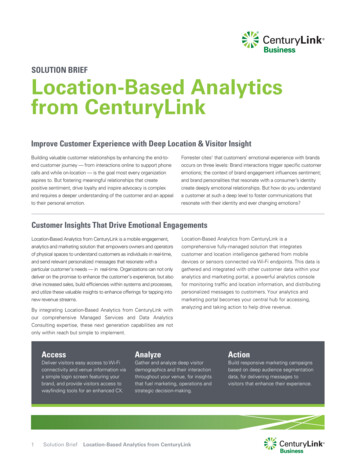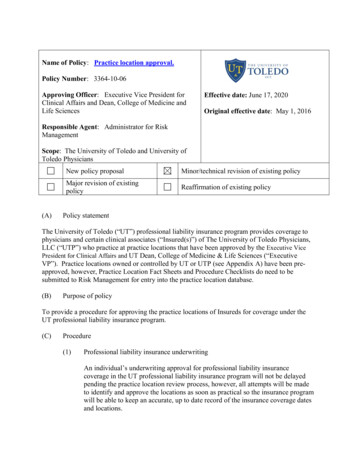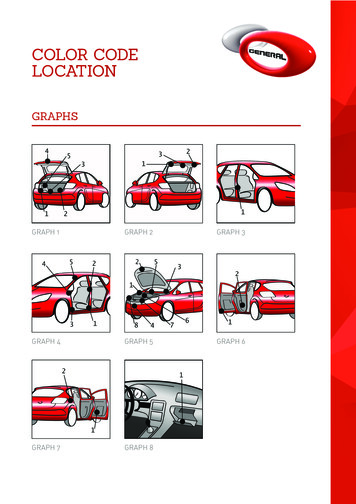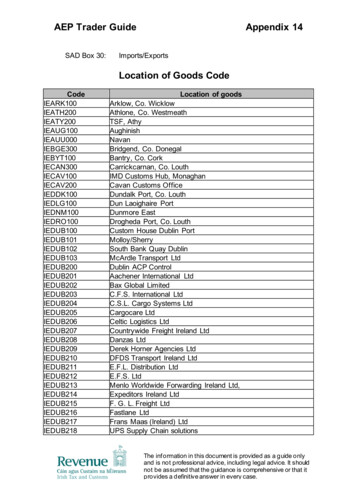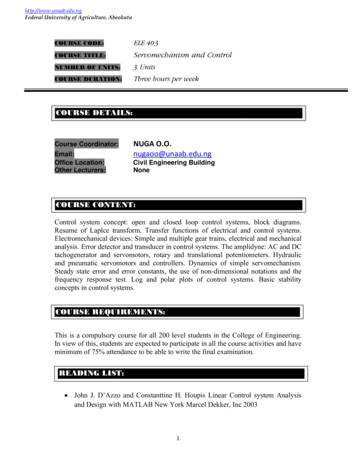
Transcription
LOCATION: A STRATEGICMARKETING IMPERATIVEHOW LOCATION-BASED MARKETING ISREINVENTING THE PATH TO PURCHASEIN ASSOCIATION WITH:
CONTENTSIntroduction. 2Keeping Pace With Consumer Expectations. 3Bridging the Gap Between Online and Offline. 5Reinventing the In-Store Experience. 6Beyond Search and Social—A New Category. 8A Look to the Future. 9Conclusion.11Acknowledgments.12
INTRODUCTIONLocation-based mobile advertising is more than simply a nice-to-have tactic in a marketer’s toolkit. Rather, it’s fastbecoming a strategic imperative in today’s data-driven, highly competitive landscape.It’s easy to understand why. Mobile is quickly surpassing desktop computers as the most essential aid for makinga purchasing decision. In fact, by 2018, global smartphone users will reach the 2.5 billion mark, according to eMarketer.And nearly 86 million consumers will make a purchase on their device in 2016. At the same time, more and more shoppersare recognizing the value exchange of sharing information, such as location data, in return for value in the form of coupons, loyalty points or relevant information about a product or service.“[Consumers] are getting more and more accustomed to the fact that their location plays an integral part in the valueproposition of the services they use,” says Joe Laszlo, vice president of industry initiatives at the Interactive AdvertisingBureau (IAB). Whereas in the past, there was “some hesitation or concern” around divulging personal details, Laszlo says,“the equation now is much clearer as far as the benefits of sharing location data.”Consumers’ expectations are also changing as apps such as Uber, Tinder and Yelp raise the bar on service delivery.Whether mapping the nearest coffee shop or swiping for the closest love connection, location data is forever changing howpeople shop, eat, date and travel. As a result, shoppers now expect in-the-moment, personalized, relevant experiences,whether purchasing products online or browsing the aisles of a brick-and-mortar retailer.For marketers, this new breed of mobile-dependent, highly demanding consumer is more than simply a challenge. It’sa prime opportunity to engage and activate customers in new and innovative ways. Chief among these new strategies islocation-based marketing. As it is, the number of location-driven apps is set to skyrocket. Over the next five years, location-based ads will make up over 40% of mobile spend, reports eMarketer. And Juniper Research reports that the numberof location-aware apps is expected to triple by 2019, making it a significant subset of the mobile application marketplace.All of which means location is fast becoming one of the most powerful means for identifying and delivering on consumers’ real-time intent. The goal is to create purchase incentives and foster engagement. As a result, location is now critical totapping into these precise moments of decision making.This paper features interviews with some of today’s leading brands on how they’ve effectively leveraged location. Basedon these shared insights, there are four key ways marketers can make the most of a consumer’s location for instant connectivity, and learn how to match real-time customer data to correct location context for an innovative digital experience.1)2)3)4)Keeping Pace With Consumer ExpectationsBridging the Gap Between Online and OfflineReinventing the In-Store ExperienceBeyond Search and Social—A New Category2 LOCATION: A STRATEGIC MARKETING IMPERATIVE
KEEPING PACE WITHCONSUMER EXPECTATIONSOne only needs to look at consumers’ changing path firms are either changing their way of doing business, alteringto purchase to understand the increasingly impor- their approach to customer experience or transforming theirtant role mobile and location plays in connecting with overall digital experience due to the rise of mobile.customers in the right place, at the right time. Thanks to theAnother demand arising from this shift in consumerproliferation of smartphones, consumers now enjoy unfettered mindset is the need for relevant interactions. Long gone areaccess to product information, pricing, business locations and the days of generic direct mail campaigns. Nowadays brandslocal deals, all via a simple mobile connection. Armed with this need to provide relevant, tailored messaging and purchaseup-to-the-minute information, today’s new breed of consumer opportunities in order to drive action. Location is proving toexpects tailored, immediate and relevant customer experiences.be the perfect tool.“In the old days, we could mass market a message on three“Location is about serving up relevant messages to contelevision networks and reach everybody,” says Angelique sumers where they can actually act on them, which is reallyKrembs, vice president of marketing activation for PepsiCo North powerful,” says Krembs. “In the days of TV-only, you wereAmerica Beverages. “But that isn’t the case today. Everything is so trying to influence consumers as they sat at home and hopedmuch more tailored to people’s tastes and behaviors.”they remembered those messages when they went to the store.In addition to more personalized communications, con- Now you can actually talk to consumers when they’re nearsumers are also demanding more immediate returns on your store, or influence them where your brands are present.”their interactions with brands. With the tap of a screen, aPepsiCo isn’t the only brand behemoth recognizing theconsumer can now order a taxi, an out-of-stock cashmere power of carefully timed, location-based marketing to meetsweater, organic produce or a date for Saturday night. Uber, high customer expectations. “Location-based services are getTinder, Yelp—they are all wildly popular apps that are reset- ting to the point where consumers are expecting messages toting consumer expectations and reducing acceptable response be tailored to them,” says Miles Marmo, brand experiencetimes from brands.manager for Mike’s Hard Lemonade Co.“Because of the role of the mobile device in people’s livesFor example, Marmo says, within the brand portfolio urbantoday, there’s a new expectation on how brands, companies, shoppers tend to purchase Mike’s Hard Lemonade products fromproducts and services interconvenience stores whileact with customers,” sayson the go. Suburban buyers,Michael Lacorazza, execuon the other hand, are moretive vice president and headlikely to browse groceryof integrated marketing atstores for product. MindfulWells Fargo. “Consumersof these distinctions in conexpect to be able to take yousumer buying patterns andwith them, they expect to belocation, Marmo says, Mike’salways on, and they expectHard Lemonade is better able— ANGELIQUE KREMBSinstant gratification.”to tailor its mobile campaignsVice President of Marketing Activation,In fact, a Forrester Researchby brand and consumer forPepsiCo North America Beveragesreport reveals that 70% ofgreater impact and relevance.marketers reported that their“We know that the creative“Now you can actually talk toconsumers when they’re nearyour store, or influence themwhere your brands are present.”COPYRIGHT 2016 FORBES INSIGHTS 3
messaging [in marketing camproducts and services on theirpaigns for urban shoppers] has tosmartphones while on thebe short, quippy and engaginggo demonstrate a great dealbecause that consumer is in andof intent to purchase and toout,” he says.purchase quickly. In fact,Dunkin’ Brands is anotheraccording to the “Mobileexample of a well-known namePath to Purchase” study,that’s leveraging location data toreleased by mobile-locationcater to customer demands forad platform xAd, on-theinstant connectivity and immego researchers are 45% more—MILES MARMOdiate gratification. “The powerlikely to make a purchaseBRAND EXPERIENCE MANAGER,of combining mobile and localwithin the hour over those atis to take 1:1 market ing to anhome—an important signalMIKE’S HARD LEMONADE CO.even more effective and perfor marketers to detect andsonal level,” says John Costello,act on quickly.president of global marketing and innovation at Dunkin’ BrandsAs consumer expectations rise, location is also set to playand the current chairman of the Mobile Marketing Association. an even larger role in the global expansion plans of some ofOne way Dunkin’ Brands accomplishes this is by crafting today’s top U.S. corporations. “Consumer worktime variescampaigns that consider a consumer’s intent. Is it a customer’s around the world, with U.S. workers starting earlier thanfirst coffee of the day? Is he handling a mid-afternoon cof- many places around the globe,” says Costello. “So the earlyfee run for his office? Is she about to stroll by a local Dunkin’ morning time period is Dunkin’ Donuts’ busiest part of theDonuts store? Or is she on a commuter train heading home for day, whereas in other countries around the world, we mightthe evening? The right location data can answer these ques- have a larger afternoon business.” Location-based markettions, enabling marketers like Dunkin’ Brands to know when ing allows brands like Dunkin’ Donuts to be sensitive toand how to reach their best customers.varying cultural and geographic sensibilities, as well as indiHow a consumer uses his or her smartphone is also a clear vidual expectations, by recognizing where consumers areindicator of intent. For instance, consumers that are researching and at what time of the day.“Location-based servicesare getting to the pointwhere consumers areexpecting messages to betailored to them.”4 LOCATION: A STRATEGIC MARKETING IMPERATIVE
BRIDGING THE GAP BETWEENONLINE AND OFFLINEGone are the days of researching a product over an of where a consumer is, where they are in the buying journey,extended period of time before making a final pur- their real-time intent, and how close they are to a retail locachasing decision. Rather, these days, buying decisions tion, Costello says, Dunkin’ Donuts “can maximize the synergyare made within seconds of identifying a need.between traditional and mobile marketing” for greater “releCertainly, mobile is helping to facilitate this speedy decision vancy and effectiveness.”making by allowing consumers to be online while on the go.Krembs of PepsiCo agrees. “In the old world, you madeIn fact, 44% of consumers report their mobile devices—smart- one big, beautiful expensive television ad and you’d run it forphones or tablets—are the most essential aid to their purchase a year. Well, those days are over.” Instead, Krembs says withdecision, according to xAd’s “Mobile Path to Purchase” study. smartphone-friendly channels like Facebook, YouTube andThis shift does not mean that mobile is limiting brick-and- Twitter, brands must view marketing as “an ecosystem of conmortar purchasing. In fact, the unique value proposition of tent that needs to be relevant to what the consumer wants tomobile-location is that it can actually bring together online and see, depending on where they are.”offline commerce for real-time, relevant engagements. “It’s veryIt’s a testament to the power of location data that’s evident inimportant to deliver the most relevant message to the right con- a recent Wells Fargo mobile campaign designed to drive greatersumer at the right time, at the right location,” says Costello. “So in-branch visitations. First, the financial services company identilocation has a real opportufied consumers whose onlinenity to make mobile even moresearch data indicated an intereffective and bridge the gapest in opening up a new bankbetween online and offline.”account. These prospectsIn the case of Dunkin’were then served a mobileDonuts, the restaurant chainad for a variety of depositstill relies on time-tested maraccount options, along withketing channels like televisiona geolocation notification—JOHN COSTELLOand radio. “Traditional marketfor the bank branch nearesting like television, out of hometo them. By leveraging locaPRESIDENT OF GLOBALand radio continue to worktion, Wells Fargo was able toMARKETING AND INNOVATION,very effectively for us,” saysbridge the divide betweenDUNKIN’ BRANDSCostello. However, by creatonline and offline worlds foring campaigns that are mindfulits mobile customers.“It’s very important to deliverthe most relevant message tothe right consumer at the righttime, at the right location.”COPYRIGHT 2016 FORBES INSIGHTS 5
REINVENTING THEIN-STORE EXPERIENCEFor all of mobile’s perks, the brick-and-mortar buying journey is very much alive and well. In fact, according to theDepartment of Commerce, 90% of retail transactions stillhappen in the real world. So the goal for marketers isn’t to replacethe offline experience with an online one but to enable a faster,more seamless purchase process. The right mobile strategy canenhance customer experience by nurturing brand-customer connections in-store.“The industry has beenthinking for a while now aboutsmartphones as the new customer service rep and thatthere are real opportunities forthe mobile phone to become amajor shopping aid,” says Laszlo.“Companies like Macy’s havemade major investments in instore wireless infrastructure thatare really pushing the envelope.”At the core of many of thesenew initiatives is location data. By tapping into what’s happening“now” with a customer, location allows marketers to deliver personalized and relevant in-store experiences in ways never beforepossible.
president of global marketing and innovation at Dunkin’ Brands and the current chairman of the Mobile Marketing Association. One way Dunkin’ Brands accomplishes this is by crafting campaigns that consider a consumer’s intent. Is it a customer’s first coffee of the day? Is he handling a mid-afternoon cof-fee run for his office? Is she about to stroll by a local Dunkin’ Donuts store .




